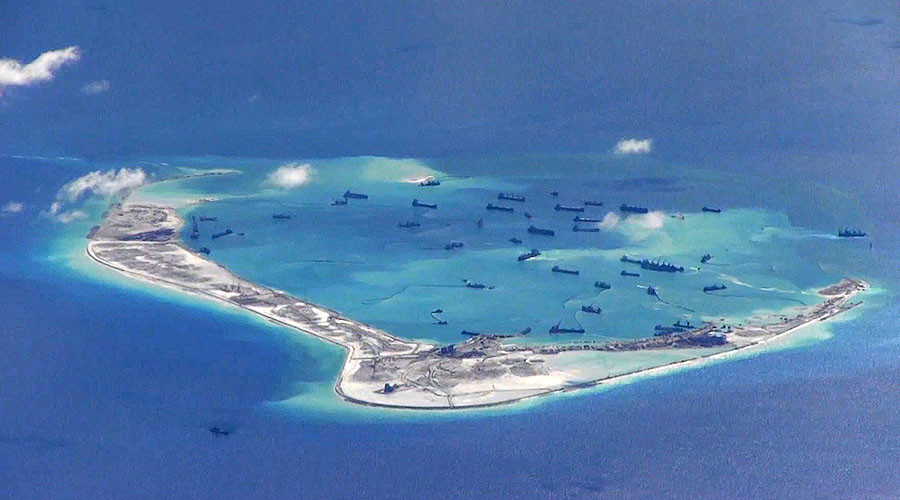
Subi Reef in the South China Sea
The South China Sea is heating up, especially with the United States conducting Freedom of Navigation Operations (FONOPs) against China near the Spratlys, Paracels, and Scarborough Shoal.
Points of disagreement
A series of strategic reports released by the Trump Administration since late 2017, including the National Security Strategy, place China as its number one strategic competitor and label it and Russia as revisionist powers. Some U.S. scholars take a very pessimistic view of U.S.-China relations and believe that this relationship is no longer characterized as cooperation with elements of competition but the other way round. They see the South China Sea as an important source of U.S.-China strategic rivalry and even assert that conflict between the two countries over the South China Sea is inevitable.
Such a view may be an overstatement. Since late 2016 the situation in the South China Sea has been stable and the territorial and maritime disputes have been under control. The South China Sea issue is temporarily not in the forefront of the agenda of the China-U.S. bilateral relations. However, the confrontation between the two countries in the South China Sea is still quietly gaining momentum and the risk of conflict cannot be disregarded.
According to some American scholars, the United States and China have overlapping strategic interests in the South China Sea: The U.S. promotes an open and free maritime order while China is challenging that order. It is in the national interest of the U.S. to ensure free access and passage of its military forces in the global public domain, including the South China Sea, while China takes the South China Sea as a “Chinese Lake” and tries to deny U.S. access to the area. One of the priorities of the Indo-Pacific strategy is maintaining the U.S.-centered alliance system and partnership network, while China is seeking dominance and excluding U.S. influence in the same region through its “Belt and Road” initiative.
These assumptions are based on a zero-sum mentality and a misreading of China’s strategic intentions. And the conclusion that U.S.-China conflict in the South China Sea is inevitable is no more than a self-fulfilling prophecy and will not provide a solution to the problem.
In order to manage and bridge their differences in the South China Sea, China and the United States should not subscribe to this preconceived idea but rather put themselves in each other’s shoes. To this end, they had better answer three questions.
What is the U.S. position on South China Sea disputes?
China is the sovereign of the Spratly islands and a major party to the territorial disputes over the archipelago. Prior to the final settlement of the disputes, China is legitimately concerned about defending and preserving its rights and interests. The measures adopted for that purpose cannot be regarded as expansionist or undermining regional order.
In accordance with its official statements, the United States does not take a position on who has sovereignty over the Spratly features, but it does have an interest in how the disputes are solved. The American officials keep saying that peaceful settlement of the disputes, which is essential under a rules-based international order, is vital to the national interest of the United States. In addition, the disputes directly involve the Philippines, an American ally. If the disputes escalate into a war or military conflict, the U.S. obligation under the alliance might be triggered and its credibility tested. Due to the asymmetry between China and other claimant states in their national powers, the United States has to play a role in maintaining the balance.
However, the fact is that China also sticks to a peaceful settlement of the South China Sea disputes. The choice is made by China on its own out of a strategic calculation of its long-term interests. It also reflects an agreement among all the parties directly concerned in the disputes. It is not a result of pressure from any third party. Anyway, if the goal of the U.S. policy is to maintain peace and stability in the South China Sea, then the difference between China and the United States in their strategic interests in the South China Sea may not be that big and irreconcilable.
The most effective way to solve a territorial dispute is through talks between the parties directly concerned. Giving a dispute too much significance does not help. Unfortunately that’s what the United States is doing with the South China Sea disputes. It also applies its alliance system to the disputes, sending a strong signal that it is actually taking sides.
In order to maintain peace and stability and ensure a peaceful settlement of the disputes in the South China Sea, what the United States has to do is not question China’s intentions to solve the disputes peacefully. Instead, it should show its own impartiality.
Cooperation or confrontation?
China is a coastal state next to the South China Sea. It means that China not only enjoys exclusive maritime rights and interests in this area under international law, but also has a direct stake in the peace, security, stability, free passage, and marine environment of the South China Sea. It has a right to a major role in any South China Sea dispute settlement. As China grows stronger, it is expected to make more input. This is beneficial to regional order and serves the international community, including the United States.
Someone may suspect that China is seeking domination in the South China Sea and trying to keep the United States out. However, this is not true. China is cooperating with other coastal states in managing South China Sea affairs. China and the ASEAN countries have signed a Declaration of Conduct in the South China Sea (DOC) and are negotiating a code of conduct in the South China Sea (COC). China is also promoting the idea of establishing a mechanism for South China Sea coastal state cooperation in accordance with Article 123 of the United Nations Convention on the Law of the Sea (UNCLOS), which stipulates that states bordering a closed or semi-enclosed sea should cooperate with each other.
In terms of the relationship with non-coastal states, there are no signs that China is denying the latter’s legitimate rights and interests in the South China Sea. In fact, the UNCLOS stipulates that coastal states, when cooperating with each other, shall endeavor to invite, as appropriate, other interested states or international organizations to cooperate with them. The provision reflects the leading role of the coastal states as well as the role that non-coastal states could play. In this sense, China and the United States are not destined to confront each other in the South China Sea, but have ample room to cooperate with each other in the region.
In the meantime, U.S. military operations in the South China Sea and other sea areas adjacent to China, and the differences between the two countries regarding the legality of these operations, do affect the environment for constructive cooperation. They are also taken as the evidence for U.S.-China strategic rivalry in the South China Sea.
When emphasizing its own strategic interest in the South China Sea, the United States has to understand that China, as a coastal state, also possesses legitimate security interests in the area. China’s security concern is defensive in nature and is not targeted against any specific country. Nor does it obstruct freedom of navigation and overflight enjoyed by any state, including the United States, in the international sea lanes of the South China Sea.
The problem is that, the U.S. military presence, including the FONOPS and other military deployments, in close vicinity of China’s territory, is aimed against China. Even the U.S. side does not deny it. In this case China has to react.
In order to constructively address the problem, what the United States should do is prove to the coastal states along the South China Sea, including China, that their security will not be affected when the United States exercises its freedom of access and passage in the area, especially by its military forces.
How do China and the U.S. view the global maritime order?
In international maritime affairs, China is a geographically disadvantaged state and a developing sea power.
Most of China’s territory, apart from Taiwan, does not face the open ocean, but is rather locked by a chain of marginal seas. In order to sail to the open seas, China has to pass through straits or narrow sea lanes either under the sovereignty of other countries or close to them. Fortunately, under the existing rules of the law of the sea, geographical disadvantages do not deprive a country of its right to go to the oceans. China, with 1/5th of the world’s population, naturally has growing interests in global marine governance, including the use and protection of the high seas and the international seabed area.
In the modern era, China’s development, the extension of its overseas interests and the re-awakening of its maritime consciousness all signify its growing maritime capability. At the same time, China is still a developing country, and its navy still falls behind that of more advanced countries. Under such circumstances, open and free marine space is in China’s interest more than that of other countries.
Since the new millennium, Chinese delegates, when addressing the oceans and the Law of the Sea at the United Nations General Assembly, have kept calling for respect for legitimate and peaceful uses of the oceans by all countries, demanding the opening of the sea, stressing that the laws and regulations of coastal states shall not damage freedom of navigation, and suggesting that new international maritime legislative processes shall not prejudice the navigational and other rights of states under international law. These positions are not in conflict with the “open and free” concept promoted by the United States. Instead the two sides should have more potential common ground.
Every sovereign state may participate in the international law making process. And labeling any other country revisionist is not constructive. Historically the major revision to the rules of the modern law of the sea actually came from concern from the United States. Upon the completion of the negotiation on the UNCLOS in 1982, the United States was dissatisfied with Part XI – the provisions governing the international seabed area – and voted against the document and didn’t ratify the Convention. The United Nations Secretary-General later convened an informal consultation and in 1994 adopted an “implementation agreement” of the UNCLOS, containing substantial modification of the relevant provisions.
The UNCLOS is a package deal reached by over 160 countries through negotiation. As a result, it does not allow for any reservation unless expressly permitted by its other articles, and provides for specific procedures for the amendments. Therefore modifying a treaty through an implementation agreement constitutes a classic case in international rule-making. Anyway, in international legislation, it is natural for every participating country to raise its concerns and leave its footprint in the process. The United States has experience of this.
In conclusion, China and the United States are not bound for conflict in the South China Sea. They do have divergent interests and friction will always exist. Whether the two countries could explore a way for positive interaction depends upon their ability to overcome the lack of mutual strategic trust and to find common interests based upon agreed norms and under the idea of building a new international relationship and a community of shared future for mankind.
(This article is from the International Public Policy Review in Singapore.)


